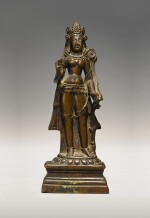Indian, Himalayan & Southeast Asian Works of Art
Indian, Himalayan & Southeast Asian Works of Art

PROPERTY FROM AN IMPORTANT NORTH AMERICAN COLLECTION
A COPPER ALLOY FIGURE OF TARA WITH SILVER INLAY, KASHMIR, 9TH/10TH CENTURY
Auction Closed
September 22, 07:46 PM GMT
Estimate
30,000 - 50,000 USD
Lot Details
Description
PROPERTY FROM AN IMPORTANT NORTH AMERICAN COLLECTION
A COPPER ALLOY FIGURE OF TARA WITH SILVER INLAY
KASHMIR, 9TH/10TH CENTURY
Height 7 ½ in. (19 cm)
Himalayan Art Resources item no. 13749.
Henry Spencers and Son Auctioneers, The Square, Retford, January 1996
Paul M Peters Fine Art Ltd, Harrogate, North Yorkshire
John Nicholson's, Haslemere, Surrey, April 18, 2018, lot 141
The goddess is identified as Tara by the akshamala in the right hand and the padma flower growing from the lotus pedestal, with the stem held in the left hand. Kashmir Buddhist sculptures depicting female deities are rare, with the vast majority of statues portraying the Buddha in various manifestations. Common stylistic features in both Hindu and Buddhist female sculptures include the tight-fitting upper garment cut to reveal the navel, the floor length diaphanous lower garment, and the beaded girdle with pendant bells, cf. a Kashmir four-armed Dhanada Tara dating to the second half of the tenth century in John Siudmak, The Hindu-Buddhist Sculpture of Ancient Kashmir and its Influences, Leiden and Boston, 2013, p. 483, pl. 230. Although the Dhanada Tara features the same costume and girdle type, the modelling and jewelry is exaggerated compared with the subtle movement and restrained detail of the present example, evidence of an earlier date for this Tara of ninth or early tenth century. The patina of the bronze is lustrous with no indication that it has been buried and subsequently excavated. This suggests that the statue may have been taken to Tibet as a devotional image, or for safekeeping during religious upheaval, like so many surviving Kashmir bronzes. Edges and details of the bronze are abraded and softened. Statues were regularly handled in Kashmir while being ritually bathed and anointed in acts of worship described by the Sanskrit term abhisekham, and the continual cleaning of bronzes during lustration leads to surface wear. Physical worship of sculpture does not occur in Tibet, and the abrasion of the bronze’s surface would have taken place prior to its leaving Kashmir.
